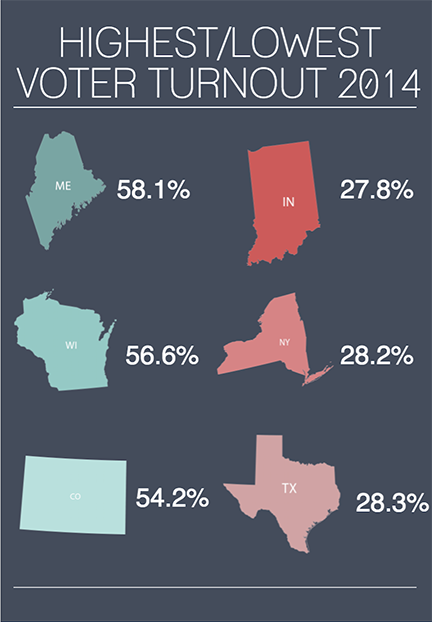The Lowest Voter Turnout in 7 Decades
A closer look at voter registration methods and voter turnout during the 2014 midterm election.

2014 set new records in low voter turnout for California during the midterm election. (Daniel Sofer/hermosawave.net)
By: Alexa Monteleone
During the 2014 midterm election, less than half of the voting-eligible population did not vote, and not a single state broke 60 percent voter turnout. Overall, the average national turnout was 36.3 percent. According to the US Census, the main reasons people did not vote were due to lack of interest, busy schedules, illness or disability, or dislike of candidate or campaign.
There are several ways to increase voter turnout by making the registration process easier and more convenient for voters. A trend that has continued to show higher rates of voter participation is states with Election Day Registration (EDR). Election Day registration warrants citizens the right to register or update their voter registration at the polls or at their local election office on Election Day and then cast their ballot.
States With Election Day Registration

States with Election Day registration had an average voter turnout of 48 percent in the 2014 midterm election, which is 12 points higher than the turnout in states without Election Day registration. Even now in 2016, only 13 states plus the District of Columbia offer Election Day registration.
There are multiple benefits to Election Day Registration such as increased voter turnout, eliminates registration deadlines, and greatly reduces the need for provisional balloting. However, there have been critiques of EDR that it encourages voters who are ill informed and/or ill-prepared voters to participate in elections.
Online voter registration is another method to increase voter participation. In 2014, 24 states have implemented or passed legislation to enact Online Voter Registration (OVR). Presently, 33 states have the ability to register to vote online.
More states across the country are increasingly adopting online voter registration to reduce costs, enhance government efficiency and build more complete and accurate voter lists. More states are open to this method of registration because reduces the reliance of paper in the registration process, it is more cost efficient and it is more accessible.
States With Online Voter Registration

In the 2014 midterm election, Maine, Wisconsin and Colorado had the highest voter turnout rates. All three states have also enacted Election Day registration. Whereas the three states with the lowest turnout, Indiana, New York and Texas do not have Election Day registration legislation passed. States with EDR on average have higher turnout rates than states without EDR.
Maine and Wisconsin do not have online voter registration implemented even though they have higher turnout rates. And states with lowest voter turnout for the 2014 midterm election, such as New York and Indiana do have online voter registration implemented. Online voter registration may be a more efficient way to get people to register to vote, but Election Day registration is more effective in increasing voter turnout.
